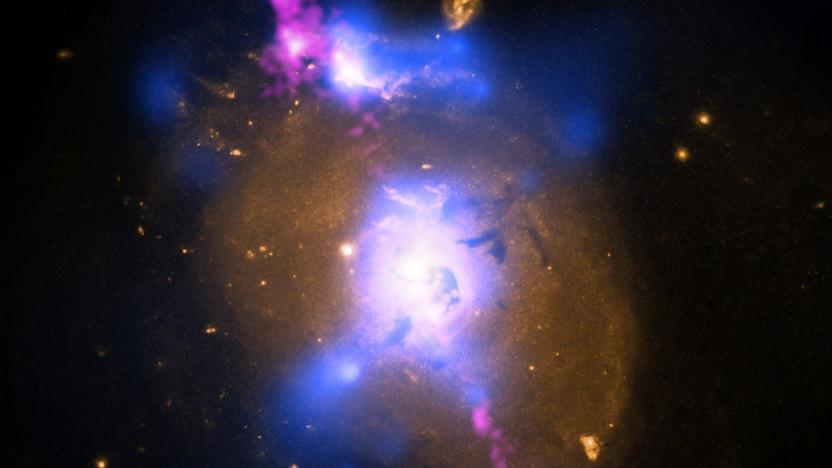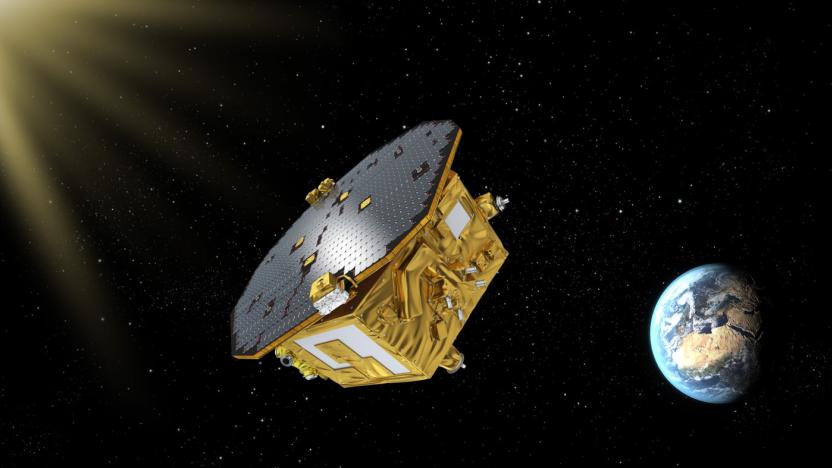theoryofrelativity
Latest

Scientists validate theory of relativity on galactic level
Einstein's theory of general relativity is rather important when it's crucial to the modern understandings of the universe and technology like satellites. But does it hold up with something as vast as a galaxy? Thanks to researchers, we know the answer is "yes." They've conducted a test that used two comparatively distant galaxies, one in front of the other, to show that relativity checks out.

Astronomers prove Einstein right: Stars can warp light
In a new study published today in Science, researchers achieved a rare event -- simultaneously proving Albert Einstein both right and wrong. The scientists were able to confirm one of Einstein's theories, something even he wasn't sure would be possible.

Event Horizon Telescope will soon take the first black hole photo
The Event Horizon Telescope (EHT) is finally ready to take a picture of Sagittarius A*. From April 5th to 14th this year, the virtual telescope that's been in the making for the past two decades will peer into the supermassive black hole in the center of our galaxy. EHT is actually an array of radio telescopes located in different countries around the globe, including the Atacama Large Millimeter/submillimeter Array in Chile.

Test can show if the speed of light has changed
Modern science assumes that the speed of light has always been the same. Researchers have suggested that this seeming constant might have changed over time, however, and they now have a way to find out whether or not that's true. Professors João Magueijo and Niayesh Afshordi have developed a prediction that should test for changes in light speed. They've given the fluctuations in density the early universe, detectable through cosmic background radiation, an exact spectral index number based on the theory that light was much faster in the first seconds following the Big Bang (0.96478, if you're curious). If future measurements of the index line up with this number, they'll support the notion that light speed has shifted.

LISA Pathfinder 'listens' to the universe while in freefall
Back in December, the European Space Agency (ESA) launched the Laser Interferometer Space Antenna (LISA) Pathfinder spacecraft. Today, it's finally positioned itself in gravitational stasis at the first Langrangian Point (L1) that lets its instruments hang in freefall. This will hopefully filter out extraneous cosmic noise so the spacecraft can achieve its mission: measuring gravitational waves, the "sound" of the universe.

Researchers use satellite launch blunder to test relativity
Pop quiz, hotshot. You've just launched a pair of GPS satellites into the wrong orbit, rendering them useless for navigation. What do you do? If you're the European Space Agency (ESA), you re-purpose them to precisely test Albert Einstein's theory that clocks slow down near heavy objects. Since the Galileo satellites were placed in elliptical, rather than circular orbits by Russian Soyuz rockets, they pass closer to Earth at certain points. Our planet bends the fabric of space-time, so the super-precise atomic clocks on-board the satnavs will theoretically slow during those times, then speed up again when the craft move away.

CERN admits faulty kit to blame for speedy neutrinos, says it's all relative
Those pesky neutrinos, they sure did cause a kerfuffle. The scientific community held its collective breath when research published by CERN suggested that the little guys had been caught traveling at an Einstein-defying 3.7 miles per second faster than light. Naturally there was a mixture of doubt and excited disbelief, but everything needed to be triple checked before any paradigms could meet any windows. And alas, it was all to unravel once flaws were identified. CERN has finally admitted faulty kit was to blame, with it's research director Sergio Bertolucci conceding "A coherent picture has emerged with both previous and new data pointing to a neutrino velocity consistent with the speed of light." The final chapter in this story took place at the International Conference on Neutrino Physics and Astrophysics in Kyoto today, with Bertolucci also commenting that, at the very least, the story captured the public imagination, pointing out that "An unexpected result was put up for scrutiny, thoroughly investigated and resolved in part thanks to collaboration between normally competing experiments. That's how science moves forward." [Image credit: Getty Images]

Remember those faster-than-light neutrinos? Great, now forget 'em
A week ago the world went wild over CERN's tentative claim that it could make neutrinos travel faster than light. Suddenly, intergalactic tourism and day trips to the real Jurassic Park were back on the menu, despite everything Einstein said. Now, however, a team of scientists at the University of Groningen in the Netherlands reckons it's come up with a more plausible (and disappointing) explanation of what happened: the GPS satellites used to measure the departure and arrival times of the racing neutrinos were themselves subject to Einsteinian effects, because they were in motion relative to the experiment. This relative motion wasn't properly taken into account, but it would have decreased the neutrinos' apparent journey time. The Dutch scientists calculated the error and came up with the 64 nanoseconds. Sound familiar? That's because it's almost exactly the margin by which CERN's neutrinos were supposed to have beaten light. So, it's Monday morning, Alpha Centauri and medieval jousting tournaments remain as out of reach as ever, and we just thought we'd let you know.

Galaxy cluster research supports Einstein's Theory of Relativity on a cosmic level
In one small win for Einstein, one giant win for mankind, scientists at the Niels Bohr Institute have proved his General Theory of Relativity on a cosmic scale through their research of large galaxy clusters. Accordingly, the clusters -- which are the largest known gravity-bound objects -- have such a strong pull that they should cause light to "redshift," or proportionally increase in wavelength, shifting towards the red end of the visible spectrum. To test it, researchers measured beams from 8,000 clusters, revealing that they do indeed cause a change in light's wavelength, supporting Einstein's theory to a T. One good turn deserves another, right Albert? Armchair cosmologists can hop on over to the source link to learn more.

NASA concludes Gravity Probe B space-time experiment, proves Einstein really was a genius
Well, it looks like Einstein knew what he was talking about, after all. Earlier this week, researchers at NASA and Stanford released the findings from their six-year Gravity Probe B (GP-B) mission, launched to test Einstein's general theory of relativity. To do so, engineers strapped the GP-B satellite with four ultra-precise gyroscopes to measure two pillars of the theory: the geodetic effect (the bending of space and time around a gravitational body) and frame dragging (the extent to which rotating bodies drag space and time with them as they spin on their axes). As they circled the Earth in polar orbit, the GP-B's gyroscopes were pointed squarely at the IM Pegasi guide star, while engineers observed their behavior. In the universe outlined by Einstein's theories, space and time are interwoven to create a four-dimensional web, atop which the Earth and other planetary bodies sit. The Earth's mass, he argued, creates a vortex in this web, implying that all objects orbiting the planet would follow the general curvature of this dimple. If the Earth's gravity had no effect on space and time, then, the position of NASA's gyroscopes would have remained unchanged throughout the orbit. Ultimately, though, researchers noticed small, but quantifiable changes in their spin as they made their way around the globe -- changes that corroborated Einstein's theory. Francis Everitt, a Stanford physicist and principal investigator for the mission, poetically explained the significance of the findings, in a statement: "Imagine the Earth as if it were immersed in honey. As the planet rotated its axis and orbited the Sun, the honey around it would warp and swirl, and it's the same with space and time. GP-B confirmed two of the most profound predictions of Einstein's universe, having far-reaching implications across astrophysics research. Likewise, the decades of technological innovation behind the mission will have a lasting legacy on Earth and in space." The GP-B mission was originally conceived more than 50 years ago, when the technology required to realize the experiment still didn't exist. In fact, the experiment didn't actually get off the ground until 2004, when the satellite was launched into orbit 400 miles above Earth. After spending just one year collecting data (and an impressive five years analyzing the information), NASA has finally confirmed something we always quietly suspected: Einstein was smart. Head past the break to see a more in-depth diagram of how the GP-B gathered its data.

Universe expansion: dark energy's out, anti-gravity's in, matter and antimatter still can't get along
Dark energy, we barely knew you, but before we ever found out if you were, in fact, the invisible hand pushing the cosmos apart, an Italian scientist ginned up a new theory that has anti-gravity doing the Yoko Ono to the universe's merry band of galaxies. Massimo Villata's theory assumes that both matter and antimatter have positive mass and energy density, which gets particles attracting particles and antiparticles attracting antiparticles through the force of gravity. To give dark matter the heave-ho from the galactic expansion equation, Villata supposes that the theory of general relativity applies in reverse to antimatter particles to create anti-gravity. And just as gravity pulls particles together, anti-gravity shoves them apart -- giving the universe its burgeoning waistline, no clown, king, or colonel required.









